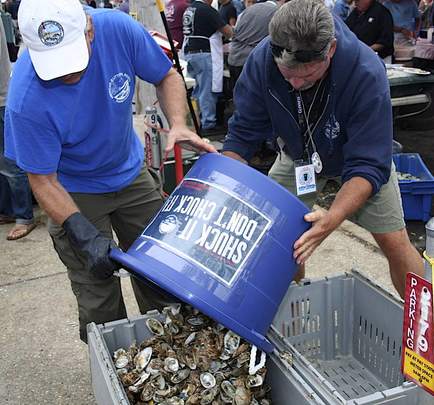|
If you're planning to visit the Red Bank Guinness and Oyster Fest this weekend, stop by the American Littoral Society tent to talk or clear your plate. We'll be right next to The Lusty Lobster stand. The festival, scheduled for Sunday, Sept. 24 from noon to 7 p.m. (rain date Sunday, Oct. 1) is one of our favorite annual events. It's not just because we like oysters and beer, but also because we love talking to people about the work we're doing locally and elsewhere. Work that often involves oysters.  Our location next to The Lusty Lobster is great because Doug Douty, who is on the Littoral Society board of trustees, serves some of the best oysters you'll find anywhere. Doug has also been crucial to our "Shuck It, Don't Chuck It!" oyster shell recycling program and wider Operation Oyster effort. Operation Oyster is a Littoral Society project aimed at putting oysters back into New Jersey's bays and tidal estuaries. New York and New Jersey -- including the Two Rivers area -- used to be considered the oyster capital of the world. Less than 100 years ago, millions of bushels of shellfish were pulled from the Delaware Bay every year. Before that the Hudson River and Raritan Bay had thriving oyster industries. Historic records show that some of the earliest human inhabitants of what is now known as Monmouth County, the Lenape Indians, considered shellfish from the Navesink and Shrewsbury rivers a primary food source. At one point Navesink oysters, often as large as dinner plates, were served in New York City's best restaurants. However, disease and decades of pollution, accelerated by rampant development and over-harvesting, decimated New Jersey's natural oyster population. That wasn't just economically devastating, there were also environmental consequences. Oysters are ecosystem engineers. Each oyster can filter up to 50 gallons of water a day. That natural filtration not only removes suspended sediments and algae, which make the water clear, it also helps prevent algae blooms and low oxygen conditions in the water. This spring the Littoral Society launched the first step of Operation Oyster: Two Rivers by hanging shell bags from docks along the Navesink and Shrewsbury rivers in order to determine if oysters are still naturally occurring in those waters. The shells in the bags all came from our oyster recycling program. We also recruited dozens of citizen scientists to help us gather information that will guide us in the next steps of the project. Soon we'll be adding an educational component through work with Rumson Middle School and opening a tank in which we will grow baby oysters. Eventually, the goal is to re-establish an oyster reef somewhere in the two rivers. The Littoral Society has already built three inter-tidal reefs along New Jersey's Delaware Bayshore and two reefs in Barnegat Bay. So if you're at the Oyster Fest on Sunday, grab a beer and a plate of Lusty Lobster oysters, then take a moment to talk to us about the work we're doing and how you can play a part. If you're too busy eating to gab, we're still happy to take your shells when you're done. We'll be sure to find a good use for them. Comments are closed.
|
Archives
July 2024
Categories
All
|


